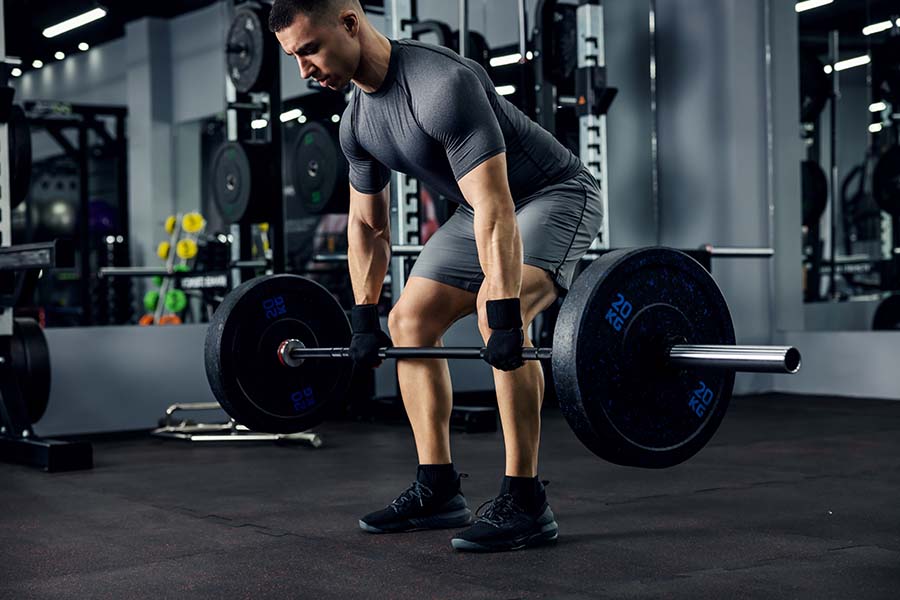Strength training can be a game-changer if you're looking to boost your fitness and health. But if you're new to the gym, it can also be a bit daunting. One of the most common questions beginners have is, "How much does the barbell weigh?" It's a valid question, as the weight of the barbell can make a significant difference in the effectiveness of your workout.
In this blog post, we'll take you through the basics of barbell weight and types of barbells and answer some common questions about choosing the right weight for your fitness level. Whether you're a gym veteran or just starting your fitness journey, grab your notebook or mobile device and let's dive into the world of barbell weight together.
How Much Does a Barbell Weigh?
Regarding barbells, the weight varies greatly depending on various factors. Let's take Olympic barbells, for example - these usually weight 45 lb (20kg), 7 feet in length, and 28mm in diameter, which is considered a heavier barbell.
On the other hand, you have standard barbells, which can range from 15-25 lb (7-11kg), making them lighter and ideal for beginners. All of this, however, depends on things such as the material used, diameter, length, knurling, and collars - all of these elements play an important role in determining the overall weight of a barbell.
Related Article: Deadlifts - 6 Proven Benefits of Deadlifts That Science Backs
Different Types of Barbell Bar and How Much It Weighs?
Barbell bars are the backbone of any weight training program. Choosing the right barbell bar is crucial for achieving your fitness goals. Each type has its unique design, weight, and features to cater to specific exercise needs, ensuring maximum performance and safety during workouts. Let's dive into some of the different types of barbell bars and how much they weigh.
Standard Barbells
These are the most common and affordable type of barbell bar, typically weighing around 25 lbs. Standard Barbells are suitable for various exercises, including squats, deadlifts, and bench presses. They are perfect for beginners looking to build strength and muscle mass.
Olympic Barbells
These are larger and heavier than standard barbells, weighing around 45 lbs. They are designed for advanced weightlifters who need a sturdy and durable barbell for Olympic-style lifts. They are used for competitive weightlifting and are suitable for exercises such as clean and jerk, snatch, and other Olympic lifts.
Swiss Barbells
These barbells have an adjustable weight system, allowing you to modify the bar's weight to suit your strength and fitness level. Depending on the weight plates used, they typically weigh around 25-55 lbs. They come in steel and a mix of steel and several other materials to choose from, suitable for those just beginning their weightlifting careers.
EZ Curl Barbells
These barbells are curved to allow a more comfortable grip for exercises like bicep curls, skull crushers, and reverse curls. They typically weigh around 40 lbs. They are designed for exercises such as triceps extensions and are suitable for taking pressure off wrists.
Safety Squat Barbells
These barbells have a unique design that allows the weight to be shifted closer to the body's center of gravity, reducing strain on the lower back during squats. They weigh around 75 lbs. They are designed for a more comfortable and natural lifting position during squats.
Powerlifting Barbells
These barbells are designed specifically for powerlifting competitions and exercises like bench presses, squats, and deadlifts. They are heavier than standard barbell bars, weighing around 45-55 lbs.
Women's Barbells
These barbells are designed with a smaller circumference and lighter weight than traditional barbells, catering to women's specific needs. They typically weigh around 15-35 lbs. They are slightly smaller and lighter than men's barbells, suitable for women's body size and strength.
Cross-Training Barbells
These barbells are versatile and can be used for various exercises and workouts, making them popular among CrossFit enthusiasts. They typically weigh around 30-44 lbs. They are designed for weightlifting, gymnastics, and high-intensity cardio with severe knurling that improves grip, making them suitable for exercises such as clean and jerk, snatch, and other CrossFit-style workouts.
Short Barbells
These barbells are shorter and smaller than standard barbells. They typically weigh around 15-35 lbs. These are designed for certain workouts such as CrossFit-style WoDs and MetCons; Power lifts like squats, bench presses, and overhead presses, suitable for individuals who have limited space in their homes or gym.
Triceps Barbells
These barbells have a unique shape, with a bend in the middle, allowing for a more comfortable grip during triceps exercises. They typically weigh around 25-40 lbs. They are suitable for exercises targeting the triceps muscle, such as extensions and close-grip bench presses, and can also be used for activities that target other muscle groups, such as the biceps and forearms.
Log Barbells
These barbells are thicker and wider than traditional barbells, simulating the feel of lifting a heavy log. They typically weigh around 75-200lbs. They are suitable for strongman training and are typically made of wood, steel, or a mix of both materials. It's important to note that the weight of a log barbell is not standardized and can vary significantly between manufacturers and models.
Hex Barbells
These barbells are shaped like a hexagon with flat sides, preventing them from rolling away during different exercises. They typically weigh around 50-65 lbs. They are designed for exercises such as deadlifts and shrugs, where the weight plates are loaded in the center of the bar rather than at the ends, allowing a more natural lifting position.
Related Article: How to Strengthen Your Shoulders and Get the Muscles You Want
Factors Affecting Barbell Weight
Weightlifting requires a barbell as an essential piece of equipment, but did you know that the weight of a barbell can vary depending on several factors? Let's dig into various factors that influence the weight of a barbell.
Barbell Type
There are different types of barbells, and each type can affect its weight. For example, a powerlifting bar weighs more than an Olympic bar because of its thicker and sturdier shaft. On the other hand, a women's bar weighs less than a men's bar because it has a smaller diameter.
Material Used
Most barbells are made of steel, but the type of steel used can affect the weight. Higher-grade steel will be more durable, but it will also add to the weight of the barbell. Some barbells use a mixture of steel and other materials, such as brass or zinc, which can also affect weight.
Barbell Length
The length of the barbell can also play a role in its weight. For example, a standard Olympic bar is 7ft long, while a women's Olympic bar is 6.5ft. This difference in length can account for a difference in weight.
Exercise Type
Different exercise routines require different weights of barbells. For instance, heavy compound exercises that engage many muscle groups, such as squats and deadlifts, require heavier barbells.
Knurling
Knurling is the rough texture on the barbell that provides a better grip. The amount and depth of knurling can affect the weight of the barbell. Deeper knurling can add weight to the barbell because it removes more metal from the surface.
Collars
Collars are the clamps used to secure the weights on the barbell. Different types of collars can affect the overall weight of the barbell. For example, spring collars weigh less than screw-on collars.
Barbell Weight Plates
The weight plates added to the barbell will determine the overall weight. Different weight plates can have slight variations in weight, and the total number of plates added can also affect the weight.
Related Article: A Full-Body Barbell Workout for Beginners That Can Build Your Gym Confidence
Top 5 Barbell Exercises for a Full-Body Workout
Incorporating barbell exercises into your workout routine can be a game-changer if you want to sculpt your muscles, improve your strength, and boost your fitness. Not only do barbell exercises help you tone your muscles, but they also provide numerous health benefits, such as improved posture, increased bone density, and enhanced cardiovascular fitness.
Check out the top 5 barbell exercises that can help you achieve a full-body workout.
Barbell Deadlift
The barbell deadlift is one of the most effective exercises for building overall strength and targeting your posterior chain muscles, including your glutes, hamstrings, and lower back. It can also enhance your grip strength and improve your posture.
How to Do It?
- To perform a barbell deadlift, stand with your feet shoulder-width apart while keeping your shins close to the bar.
- Grab the bar with an overhand grip, keeping your back straight and chest up, and then lift the bar by extending your knees and hips.
Barbell Squat
The barbell squat is a classic compound exercise that targets your lower body muscles, including your quadriceps, hamstrings, and glutes. It is also an excellent exercise for strengthening your core and improving your balance.
How to Do It?
- Stand with your feet shoulder-width apart to perform a barbell squat while holding the barbell behind your head.
- Bend your knees and lower your body until your thighs parallel the ground, ensuring your knees don't extend past your toes.
- Then, extend your legs and return to the starting position.
Barbell Bench Press
The barbell bench press is an upper-body exercise that targets your chest, shoulders, and triceps, making it an excellent exercise for building upper-body strength and size.
How to Do It?
- To perform a barbell bench press, lie on a flat bench, keep your feet on the ground, and grab the bar with a medium-width grip.
- Then, lower the bar to your chest, keeping your elbows tucked in, and press the bar back up to the starting position.
Barbell Overhead Press
The barbell overhead press is a compound exercise that targets your shoulders, triceps, and upper back. It is also an excellent exercise for improving your posture and stability.
How to Do It?
- To perform a barbell overhead press, clean the bar to your shoulders and then press it above your head, making sure to keep your core engaged and elbows tucked in.
- Lower the bar back down to your shoulders and repeat.
Barbell Bent-Over Row
The barbell bent-over row is a compound exercise that targets your back muscles, including your lats, rhomboids, and traps. It is also an excellent exercise for targeting your biceps and forearms.
How to Do It?
- To perform a Barbell Bent-Over Row, hinge at your hips, keeping your back straight and chest up, and grab the bar with an overhand grip.
- Pull the bar towards your chest, keeping your elbows tucked in, and then lower the bar back down to the starting position.
Related Article: 4-Day Barbell Workout Without a Rack for Complete Muscle Gain
Conclusion
Barbells are a great way to add variety to your workout routine. However, its weight depends on the type of barbell you have. For example, regular Olympic barbells can weigh 45 lbs, while specialized training bars may only weigh 15 lbs.
Additionally, you can also add weights to a barbell with plates ranging from 2.5 lbs to 45 lbs, depending on your fitness goals. Understanding how much your barbell weighs can be important for planning workouts and tracking progress, as well as establishing a proper form.
Finally, don't forget to consider the length of a barbell when figuring out its weight since longer bars usually mean more weight!











